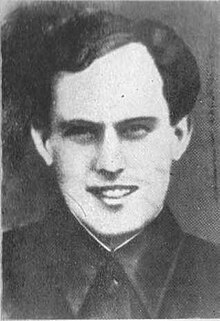Gevork Alikhanyan
Gevork Alikhanyan | |
|---|---|
 | |
| Head of the Cadre Department of the Executive Committee of Communist International | |
| In office 1935–1937 | |
| First Secretary of the Communist Party of Armenia | |
| In office December 31, 1920–April 1921 | |
| Preceded by | position created |
| Succeeded by | Askanaz Mravyan |
| Personal details | |
| Born | Gevork Sarkisovich Alikhanyan 1897 Tiflis, Tiflis Governorate, Russian Empire (now Tbilisi, Georgia) |
| Died | February 13, 1938 (aged 40–41) Kommunarka Shooting Ground, Moscow, Russian SFSR, USSR |
| Political party | Communist Party of Armenia |
| Children | Yelena Bonner |
Gevork Sarkisovich Alikhanyan (Armenian: Գևորգ Սարկիսովիչ Ալիխանյան) (1897–1938), also known in Russian as Georgy Alikhanov (Russian: Георгий Алиханов), was a Soviet Armenian politician and statesman. Alikhanyan is best known for being the founding First Secretary of the Communist Party of Armenia from 1920 to 1921. He was also a high-ranking member of Comintern before his arrest and execution during the Great Purge.
Early life
[edit]Gevork Alikhanyan was born in 1897 in Tiflis in the Russian Empire (modern day Tbilisi, Georgia). He was an ethnic Armenian.
He studied at Nersisian School in Tbilisi, where he befriended Anastas Mikoyan, a fellow Armenian student with similar communist ideals who would later become head of state of the Soviet Union.[1] Alikhanyan graduated in 1917.
Career
[edit]Alikhanyan began his career in politics when he joined the Armenian Revolutionary Federation. Inspired by Mikoyan, he switched parties and joined the Bolshevik faction of the Russian Social Democratic Labour Party (RSDLP).[2] He served as a Bolshevik representative in Tbilisi and Baku from 1918 to 1920.[3]
The Communist Party of Armenia was established on December 31, 1920, with Alikhanyan being chosen as its inaugural First Secretary. He served in this position for the first four months of 1921, being succeeded by Askanaz Mravyan in April of that year.[1]
After serving as First Secretary, he represented the Communist Party of Armenia in several district committees in Moscow, Leningrad, and Vyborg. He served in these positions until 1931.
In 1931, Alikhanyan joined Comintern. In 1935, he was promoted to the Executive Council of Communist International (ECCI) as the head of the Cadre Department.[4] During his time in the ECCI, he was one of the few senior members responsible for perpetrating the false allegations that led to the arrest and execution of Hungarian communist Lajos Magyar for allegedly assassinating Soviet politician Sergei Kirov.[5]
Arrest and death
[edit]In June 1937, Alikhanyan and his wife were arrested by the NKVD on the orders of Ivan Serov and Lavrentiy Beria, charged with allowing "undesirables" into the organization and suppressing criticism of his department.[4] He was found guilty of "participation in a counter-revolutionary terrorist organization" by the Supreme Court and subsequently sentenced to death.[6]
His execution took place on February 13, 1938, at Kommunarka Shooting Ground in Moscow, where he was shot and killed.
He was rehabilitated in 1954.[6]
Family
[edit]Around 1924, Alikhanyan married Ruth Bonner, a Jewish pro-communist activist from Siberia. Bonner had previously been married to an Armenian man named Levon Kacharyan, with whom she had a daughter named Lusik. Kocharian died a year after Lusik's birth and Ruth remarried to Alikhanyan who adopted Lusik. Alikhanyan and his family resided in Moscow and Leningrad.[7]
Ruth, arrested with her husband, was sentenced to eight years in a Kazakhstani gulag and was released in 1946. She became one of the first Purge survivors to be rehabilitated by the Khrushchev government, along with her husband's posthumous rehabilitation shortly after. She died in Moscow in 1987.[8]
Lusik Alikhanova grew up to be known as Yelena Bonner, a prominent Soviet dissident and human rights activist. She married Nobel Prize winning physicist Andrei Sakharov in 1972 and faced internal exile several times.[7]
References
[edit]- ^ a b Mehdiyev, Gaffar Çakmaklı (2020). Anastas Mikoyan: Confessions of an Armenian Bolshevik. Ankara, Turkey: Terazi Publishing. p. 15. ISBN 9786056919947.
- ^ Gore, Patrick Wilson (2008). 'Tis Some Poor Fellow's Skull: Post-Soviet Warfare in the Southern Caucasus. iUniverse. p. 39. ISBN 9780595486793.
- ^ "Alikhanyan Gevorg". Hayazg.info. 2017-04-15.
- ^ a b Chase, William (2011). "Scapegoating One's Comrades in the USSR, 1934-1937". Russian History. Ad Fontes: Essays in Russian and Soviet History, Politics, and Society in Honor of Orysia Karapinka. Part 2. 38 (1). Leiden, Netherlands: Brill Publishers: 23–41. doi:10.1163/187633111X549588. JSTOR 24665380 – via JSTOR.
- ^ Nation, R. Craig (2004). "Reviewed Work: Enemies within the Gates? The Comintern and the Stalinist Repression, 1934–1939 by William J. Chase". Journal of Cold War Studies. 6 (4) (Fall 2004 ed.). Cambridge, Massachusetts: The MIT Press: 174–177. doi:10.1162/jcws.2004.6.4.174. JSTOR 26925441. S2CID 152526356 – via JSTOR.
- ^ a b "Elena Bonner". The Independent Institute. Retrieved 2023-08-11.
- ^ a b "Jews in the Red Army, 1941–1945: Elena Bonner". Yad Vashem.
- ^ Gessen, Masha (1 May 2010). "Умерла Елена Боннэр". Snob.ru (in Russian). Retrieved 2023-08-11.
- 1897 births
- 1938 deaths
- Armenian communists
- Armenian revolutionaries
- Armenian Revolutionary Federation politicians
- Executed politicians
- Executive Committee of the Communist International
- First secretaries of the Armenian Communist Party
- Great Purge victims from Armenia
- Members of the Communist Party of the Soviet Union executed by the Soviet Union
- Revolutionaries from Georgia (country)
- Russian Social Democratic Labour Party members
